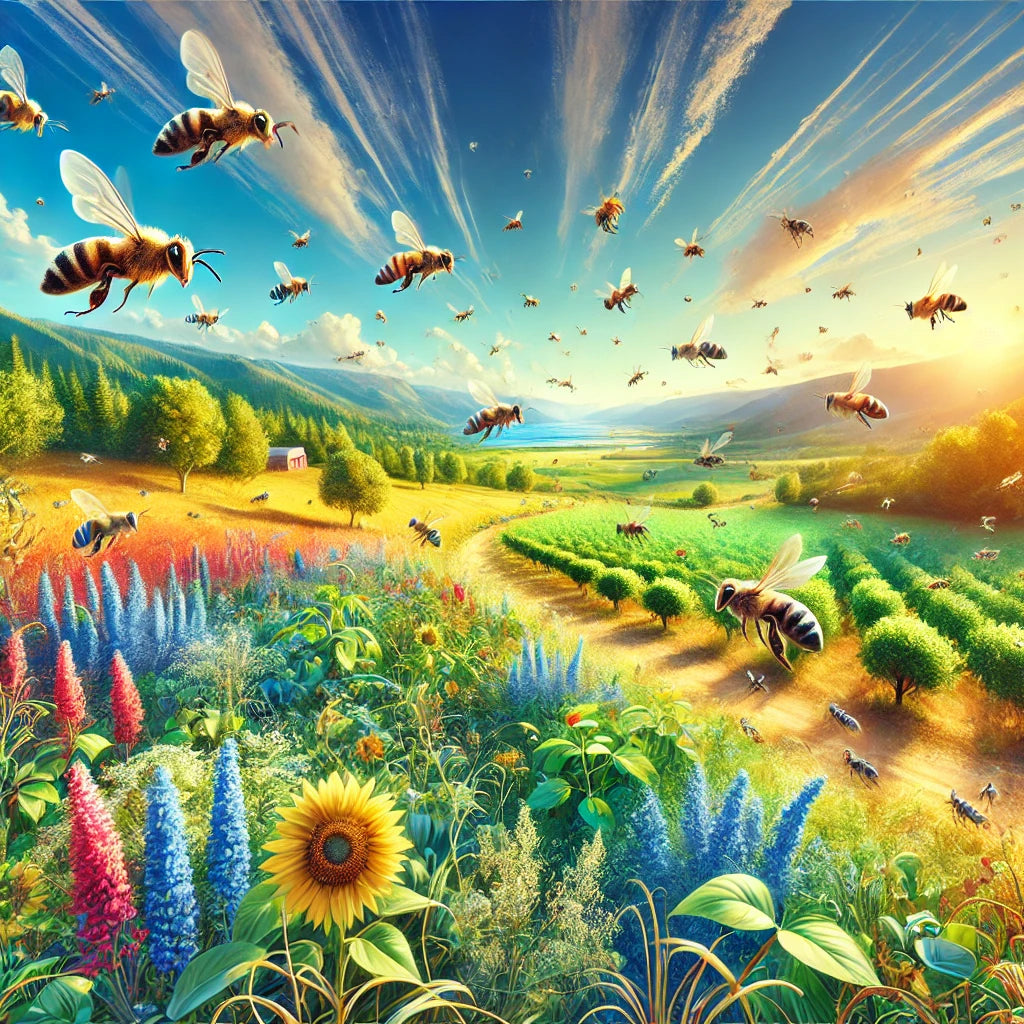Honey bees are incredible creatures, capable of traveling vast distances to gather nectar, pollen, and water for their colony. But exactly how far do honey bees travel from their hive? While this distance can vary depending on several factors, most honey bees can fly anywhere between 1 to 5 miles from their hive in search of resources.
Let’s dive deeper into what influences their travel range and how their foraging habits impact both their health and the surrounding ecosystem.
Average Distance Honey Bees Travel
On average, a honey bee will travel up to 5 miles from its hive, but some can go as far as 6 miles under optimal conditions. This foraging range allows bees to access a diverse array of flowers, plants, and water sources, helping them support the entire colony.
For most foraging flights, bees aim to stay within a 2- to 3-mile radius from the hive to conserve energy. Shorter trips mean more frequent foraging runs, which is crucial when the colony is producing honey. However, during times of scarcity, bees are capable of flying much farther to find resources, making them efficient and adaptable foragers.
Factors Affecting How Far Honey Bees Travel
Several key factors influence how far honey bees travel from their hive:
- Availability of Resources: When nectar, pollen, and water sources are abundant near the hive, bees don’t need to travel far. However, during droughts, dry seasons, or in areas with few flowers, bees will extend their range to ensure they bring enough resources back to the hive.
- Season and Weather: Bees prefer flying in warm, sunny weather. During colder or rainy days, they tend to stay closer to the hive. In spring and summer, when plants are in full bloom, bees are more likely to make longer trips as flowers further away from the hive start to open up.
- Colony Health: A strong, healthy colony will have bees with enough energy to fly longer distances. Weaker colonies may not be able to send their foragers as far, which can impact honey production and the general health of the hive.
How Bees Navigate Long Distances
Bees are exceptional navigators. They use a combination of the sun’s position, visual landmarks, and their sense of smell to find their way back to the hive after traveling long distances. When a scout bee finds a promising food source, it returns to the hive to perform a waggle dance—a behavior that communicates the distance and direction of the resource to other bees in the colony.
This communication system allows the colony to optimize its foraging efforts, ensuring that bees maximize their energy efficiency by visiting the most productive food sources. The role of scouts in foraging aligns closely with the life cycle of bees and their constant search for food to feed their growing brood.
Importance of Foraging Distance in Agriculture
Bees are vital to agriculture because they are essential pollinators. The farther bees travel, the more plants and crops they can pollinate, contributing to food production and biodiversity.
Understanding why honey bees are so vital to agriculture highlights the importance of ensuring that bees have access to diverse foraging areas. This is especially important for large-scale farms that rely on bees to pollinate expansive fields.
How Beekeepers Can Help Bees Forage Efficiently
For beekeepers, ensuring that bees have access to nearby flowering plants is key to their colony’s success. Planting diverse, bee-friendly flowers and shrubs close to the hive will reduce the distance bees need to travel. Using tools like bee trap attractants can help guide bees to specific areas for foraging, making their trips more efficient.
For those just starting their beekeeping journey and learning how to start a bee farm, understanding foraging distances and creating a rich environment around the hive can make a big difference in honey production and colony health.
Optimize Your Hive’s Foraging with SwarmCommander
By understanding how far honey bees travel from their hive, you can make informed decisions to support their foraging habits. Providing nearby resources and minimizing travel distances helps maintain energy levels and increases honey production. Whether your bees travel a short distance or extend further, ensuring they have access to ample nectar and pollen sources is vital to the success and growth of your bee colony. For beekeepers, balancing distance and resource availability is key to a productive hive.
Maximizing your bees' foraging efficiency is essential, but protecting your hives is just as important. Ensure your bees’ safety while they travel and forage by using products that enhance hive health. Visit Swarm Commander to discover solutions like bee trap attractants to help guide foraging and beetle traps for beehives to keep pests at bay, ensuring a thriving colony and a productive beekeeping season.
Frequently Asked Questions About How Far Honey Bees Travel
Q1. Can honey bees travel more than 5 miles?
Yes, in some cases, honey bees have been recorded traveling up to 6 miles from their hive when resources are scarce.
Q2. How do bees find their way back to the hive after traveling far?
Bees use the sun's position, visual landmarks, and their sense of smell to navigate back to the hive after long-distance flights.
Q3. Does the distance bees travel affect honey production?
Yes, the farther bees travel, the more energy they expend. If resources are too far, it may reduce honey production as bees need to consume more nectar to fuel their flights.
Q4. How far do bees travel in poor weather?
In poor weather, bees tend to stay closer to the hive, sometimes limiting their foraging range to less than 1 mile.
Q5. What can I plant near my hive to reduce the distance my bees need to travel?
Consider planting a variety of native, bee-friendly flowers like clover, lavender, and sunflowers close to the hive to ensure a nearby food source.



